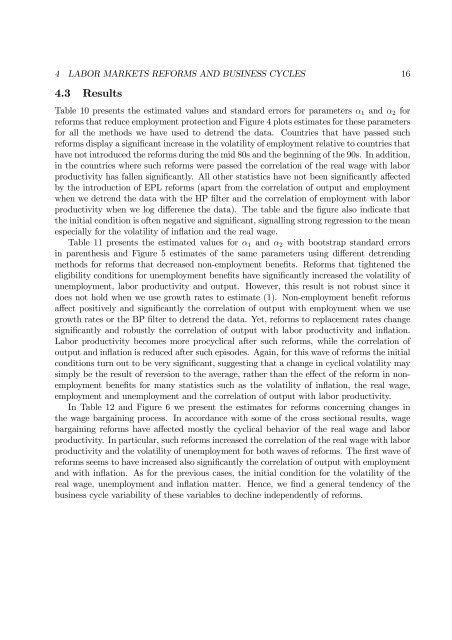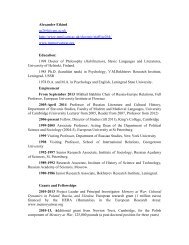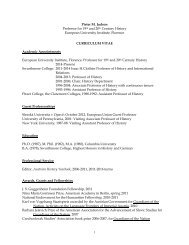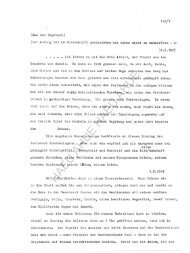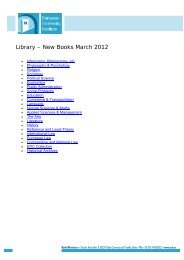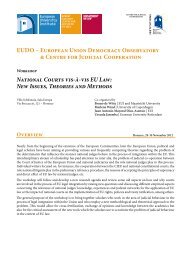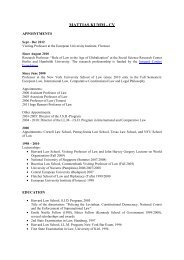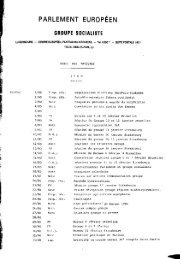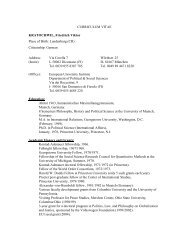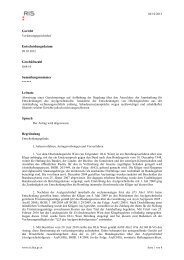Do labor market institutions matter for business cycles?∗ - European ...
Do labor market institutions matter for business cycles?∗ - European ...
Do labor market institutions matter for business cycles?∗ - European ...
You also want an ePaper? Increase the reach of your titles
YUMPU automatically turns print PDFs into web optimized ePapers that Google loves.
4 LABOR MARKETS REFORMS AND BUSINESS CYCLES 16<br />
4.3 Results<br />
Table 10 presents the estimated values and standard errors <strong>for</strong> parameters α 1 and α 2 <strong>for</strong><br />
re<strong>for</strong>ms that reduce employment protection and Figure 4 plots estimates <strong>for</strong> these parameters<br />
<strong>for</strong> all the methods we have used to detrend the data. Countries that have passed such<br />
re<strong>for</strong>ms display a significant increase in the volatility of employment relative to countries that<br />
have not introduced the re<strong>for</strong>ms during the mid 80s and the beginning of the 90s. In addition,<br />
in the countries where such re<strong>for</strong>ms were passed the correlation of the real wage with <strong>labor</strong><br />
productivity has fallen significantly. All other statistics have not been significantly affected<br />
by the introduction of EPL re<strong>for</strong>ms (apart from the correlation of output and employment<br />
when we detrend the data with the HP filter and the correlation of employment with <strong>labor</strong><br />
productivity when we log difference the data). The table and the figure also indicate that<br />
the initial condition is often negative and significant, signalling strong regression to the mean<br />
especially <strong>for</strong> the volatility of inflation and the real wage.<br />
Table 11 presents the estimated values <strong>for</strong> α 1 and α 2 with bootstrap standard errors<br />
in parenthesis and Figure 5 estimates of the same parameters using different detrending<br />
methods <strong>for</strong> re<strong>for</strong>ms that decreased non-employment benefits. Re<strong>for</strong>ms that tightened the<br />
eligibility conditions <strong>for</strong> unemployment benefits have significantly increased the volatility of<br />
unemployment, <strong>labor</strong> productivity and output. However, this result is not robust since it<br />
does not hold when we use growth rates to estimate (1). Non-employment benefit re<strong>for</strong>ms<br />
affect positively and significantly the correlation of output with employment when we use<br />
growth rates or the BP filter to detrend the data. Yet, re<strong>for</strong>ms to replacement rates change<br />
significantly and robustly the correlation of output with <strong>labor</strong> productivity and inflation.<br />
Labor productivity becomes more procyclical after such re<strong>for</strong>ms, while the correlation of<br />
output and inflation is reduced after such episodes. Again, <strong>for</strong> this wave of re<strong>for</strong>ms the initial<br />
conditions turn out to be very significant, suggesting that a change in cyclical volatility may<br />
simply be the result of reversion to the average, rather than the effect of the re<strong>for</strong>m in nonemployment<br />
benefits <strong>for</strong> many statistics such as the volatility of inflation, the real wage,<br />
employment and unemployment and the correlation of output with <strong>labor</strong> productivity.<br />
In Table 12 and Figure 6 we present the estimates <strong>for</strong> re<strong>for</strong>ms concerning changes in<br />
the wage bargaining process. In accordance with some of the cross sectional results, wage<br />
bargaining re<strong>for</strong>ms have affected mostly the cyclical behavior of the real wage and <strong>labor</strong><br />
productivity. In particular, such re<strong>for</strong>ms increased the correlation of the real wage with <strong>labor</strong><br />
productivity and the volatility of unemployment <strong>for</strong> both waves of re<strong>for</strong>ms. The first wave of<br />
re<strong>for</strong>ms seems to have increased also significantly the correlation of output with employment<br />
and with inflation. As <strong>for</strong> the previous cases, the initial condition <strong>for</strong> the volatility of the<br />
real wage, unemployment and inflation <strong>matter</strong>. Hence, we find a general tendency of the<br />
<strong>business</strong> cycle variability of these variables to decline independently of re<strong>for</strong>ms.


